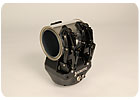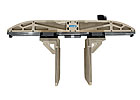
Lizards, cockroaches, wood and coffee grounds.
No, those are not the contents of a basket on the latest episode of the Food Network show “Chopped.” Rather, they are the inspirations for a slew of new robotic grippers that have recently been introduced or are right around the corner. These range from multifingered grippers that resemble a human hand to a flexible, extendable device that flicks in and out like a chameleon’s tongue.
Today, robots have two options for picking up a part: vacuum cups or a two-fingered gripper. The primary limitation of these technologies is that they’re not very flexible. If the robot has to set down one part and pick up a different one, it will likely need a new gripper. Engineers can get around that problem by equipping the robot with an automatic tool changer or mounting a pair of grippers on a rotary actuator.
In many cases, a better solution would be to equip the robot with a gripper that can grasp parts in a variety of shapes and sizes.
One such device is the new PZH-SF large-stroke gripper from SCHUNK Inc. The gripper has three swiveling fingers that move concentrically. The opening stroke per finger amounts to 113 millimeters of radial travel. Depending on the jaw position, the gripper handles components with diameters ranging from 100 to 430 millimeters. For larger diameters or special requirements, the length and the orientation of the three swiveling arms, as well as the length and shape of the fingers, can be individually adjusted.
With a gripping force of 1,500 newtons, it can handle parts weighing up to 11.8 kilograms. Like conventional grippers, it can be equipped with magnetic field sensors or inductive sensors to detect the presence or absence of parts.
Other companies have introduced grippers modeled after the human hand. One such device was introduced by Canadian start-up Robotiq at the Automate show in Chicago in March.
The S-model adaptive gripper has three articulated fingers. Each independently operating finger has three joints, and the gripper has 10 contact points with which to grasp and hold parts (three on each finger, plus the base). The fingers and their pads are replaceable.
Similar to the SDH hand from SCHUNK and the BHD-280 hand from Barrett Technology Inc., this servo-driven gripper has four grasping modes:
• Cylindrical, in which all three fingers encircle an object, such as a pipe.
• Spheroid, in which the tips of all three fingers spread out to grip an object.
• Pinch, in which the tips of all three fingers converge to grip an object.
• Scissor, in which the tips of just two fingers grip an object, like a conventional two-fingered angular gripper.
A built-in controller and mechanical intelligence enables the gripper to adapt to different parts on the fly. Sensorless grip detection and controllable closing speed and gripping force allow the gripper to handle delicate parts without crushing them. The gripper can be installed on a wide range of robots and programmed via their teach pendants.
The gripper can grasp objects as wide as 160 millimeters. It weighs 2.2 kilograms and can carry parts weighing up to 10 kilograms. The maximum gripping torque at the base of each finger is 2 newton-meters, and the maximum gripping force at the fingertips is 50 newtons.
While the Robotiq hand relies on sensors and built-in intelligence, researchers at Harvard University’s Biorobotics Laboratory have taken the opposite approach. They have developed a four-fingered mechanical hand that is flexible enough to glide along objects until it wraps around them, just like a human hand lifting a coffee cup.
“Both humans and robots have trouble estimating the relationship between their hand and the object they want to grasp,” explains Robert D. Howe, the laboratory’s head. “Humans compensate for errors by opening their hands and making their fingers soft and flexible, so they can glide along an object’s edge before wrapping around it to pick it up.
“The traditional approach in robotics…is to deal with errors using elaborate sensors, motors and controls. The resulting mechanical hands are very complex and expensive. They are also slow, since they require lots of computing power to perform even the simplest tasks.”
In designing their hand, Howe and his team took inspiration from cockroach legs. A roach’s legs are flexible and springy, which enables the insect to adjust to uneven surfaces automatically, without thinking.
The Harvard hand consists of four double-jointed, spring-loaded plastic fingers. Two motors control each pair of fingers through cables and pulleys.
At rest, the hand’s joints are opened from 25 to 45 degrees. The joints at the hand’s palm are more flexible than the joints of the fingers. Sensors measure the angle of the fingers and detect when a finger touches an object. While the hand can automatically adjust to small positional errors, the sensors enable it to compensate for larger errors.

This robot can climb vertical walls thanks to tank treads made from an electroadhesive film. The same material could enable generic grippers to pick up a wide variety of objects. Photo courtesy SRI International
Sticky Fingers
Another issue with conventional grippers is how well they hang on to an object once they pick it up. The aluminum fingers on a two-fingered gripper are typically custom-machined to match specific features on a part. Unlike a human finger, the -aluminum surface produces little friction and has no inherent ability to hold the part.If the gripper itself had some inherent stickiness, it could pick up a broader range of parts and require less force to do it. Such was the impetus behind an electroadhesive plastic film developed by scientists at SRI International, an independent nonprofit research institute in Menlo Park, CA.
The scientists developed a polymer film with a high-voltage, low-power circuit printed on it. Applying 7,500 volts at 50 to 100 microamperes of current makes the plastic film sticky enough to support small loads. Turn the current off, and the stickiness dissipates within a few seconds.
A gripper equipped with pads of the electroadhesive film could pick-and-place a variety of objects. The film adheres to myriad surfaces: conductive and nonconductive, smooth and rough, clean and dirty. It applies a clamping pressure of 0.8 to 2.3 pounds per square inch.
A lizard was the inspiration for Alexis Debray, an engineer at Canon Inc. in Tokyo. Looking for a way to pick-and-place small parts, Debray has developed a robotic end-effector that extends and retracts like a chameleon’s tongue.
The chameleon has a sticky tongue that it uses to catch insects. The tongue can snap out to nearly twice the lizard’s body length at a speed of 10 meters per second. Even at such speeds, however, the tongue exerts little force on the target. That’s key, because the lizard wants to catch the insect, not knock it away. When the tongue is fully extended, a concertina-like muscle pulls it, and the insect, back into the lizard’s mouth.
To mimic that process, Debray fixed a magnet representing the tip of the chameleon’s tongue to a stretchy, silicone-based polymer and a length of string. Debray can fire the magnet at a target through a cylindrical electromagnet. The string and elastomer can extend 30 centimeters. A motor keeps tension on the string, giving the magnet a light touch on the target. The motor then reels in the string to retract the assemblage.
To improve accuracy, small wings could be fitted to the magnet to keep it aloft longer and guide its trajectory. In the future, Debray hopes to develop a small gripper for the end-effector, so it can pick up nonmagnetic parts. He is also working on a way to link the actuator to a vision-guidance system.
Debray reports on his research in the June 2011 issue of the journalBioinspiration and Biomimetics.

Researchers from Cornell University, the University of Chicago, and iRobot Corp. have created a universal gripper from a latex balloon filled with coffee grounds. Photo courtesy Cornell University
Regular or Decaf?
Another way to get around the need to create custom gripper fingers is to do away with fingers altogether. That was the approach taken by a team of researchers from Cornell University, the University of Chicago, and iRobot Corp. They created their universal robotic gripper from a latex party balloon filled with coffee grounds.The coffee-filled balloon presses down and deforms around the object to be picked up. Then, a vacuum sucks the air out of the balloon, solidifying its grip. When the vacuum is released, the balloon becomes soft again, and the gripper lets go.
“The ground coffee grains are like lots of small gears,” says Hod Lipson, an associate professor of mechanical engineering and computer science at Cornell. “When they are not pressed together, they can roll over each other and flow. When they are pressed together just a little bit, the teeth interlock, and they become solid.”
The gripper can pick and place objects as diverse as a raw egg, a large spring, a coin and a glass tumbler.

The fingers on this gripper are made from plywood. Photo courtesy SCHUNK Inc.
Saving Weight
Weight is another challenge for engineers designing a robotic application. Because the gripper is part of the robot’s total payload, every ounce of weight taken up by the gripper is an ounce the robot can’t pick up. Reducing the weight of the gripper also helps the robot to move faster and more accurately. Less weight means less settling time and lower moment loads on the robot’s wrist.To reduce gripper weight, engineers are experimenting with unconventional materials, such as carbon composites and rapid prototyping plastics. For example, SCHUNK introduced a gripper made from wood at the Automatica trade fair in Munich last summer. “Compared with gripping modules made from aluminum, wood…has good rigidity and weighs a third less,” says Matthias Poguntke, head of product management at SCHUNK’s automation business unit.
Poguntke also likes the fact that wood is a renewable resource and easily machined.
SCHUNK uses crosswise-glued plywood for the new gripper. In contrast to solid wood, plywood has no uniform direction of fiber. The individual layers are stabilized by the adhesive, so there’s no risk of contraction or swelling of the material.
However, because wood is naturally porous, the gripper is actuated by small servomotors rather than pneumatics. For the same reason, the gripper can only be used in dry environments.

In pinch mode, all three fingers of the S-model adaptive gripper converge to grasp small objects, like this valve. Photo courtesy Robotiq
ASSEMBLY ONLINE
For more information on grippers, visit www.assemblymag.com to read these articles:•Assembly Showroom: SCHUNK Inc.
•Assembly Automation: Make Grippers More Productive.
•X-Y-Z: Grippers Give Robots a Hand.

